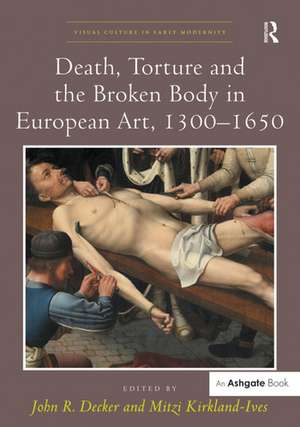Death, Torture and the Broken Body in European Art, 1300–1650: Visual Culture in Early Modernity
Editat de John R. Decker, Mitzi Kirkland-Ivesen Limba Engleză Hardback – 28 dec 2014
Din seria Visual Culture in Early Modernity
- 22%
 Preț: 324.16 lei
Preț: 324.16 lei - 18%
 Preț: 911.53 lei
Preț: 911.53 lei -
 Preț: 311.37 lei
Preț: 311.37 lei - 9%
 Preț: 1022.24 lei
Preț: 1022.24 lei -
 Preț: 312.12 lei
Preț: 312.12 lei -
 Preț: 356.69 lei
Preț: 356.69 lei -
 Preț: 313.67 lei
Preț: 313.67 lei -
 Preț: 432.98 lei
Preț: 432.98 lei - 12%
 Preț: 343.55 lei
Preț: 343.55 lei - 25%
 Preț: 324.16 lei
Preț: 324.16 lei - 25%
 Preț: 769.92 lei
Preț: 769.92 lei - 13%
 Preț: 338.33 lei
Preț: 338.33 lei - 17%
 Preț: 259.98 lei
Preț: 259.98 lei - 25%
 Preț: 326.11 lei
Preț: 326.11 lei -
 Preț: 471.08 lei
Preț: 471.08 lei - 28%
 Preț: 826.84 lei
Preț: 826.84 lei - 26%
 Preț: 819.90 lei
Preț: 819.90 lei - 28%
 Preț: 878.42 lei
Preț: 878.42 lei - 28%
 Preț: 829.69 lei
Preț: 829.69 lei - 25%
 Preț: 325.43 lei
Preț: 325.43 lei - 30%
 Preț: 853.03 lei
Preț: 853.03 lei - 13%
 Preț: 338.33 lei
Preț: 338.33 lei - 30%
 Preț: 830.92 lei
Preț: 830.92 lei - 16%
 Preț: 338.33 lei
Preț: 338.33 lei - 25%
 Preț: 826.01 lei
Preț: 826.01 lei - 30%
 Preț: 772.60 lei
Preț: 772.60 lei - 18%
 Preț: 1017.63 lei
Preț: 1017.63 lei - 30%
 Preț: 768.62 lei
Preț: 768.62 lei - 13%
 Preț: 338.33 lei
Preț: 338.33 lei - 22%
 Preț: 324.16 lei
Preț: 324.16 lei - 30%
 Preț: 772.76 lei
Preț: 772.76 lei - 11%
 Preț: 347.33 lei
Preț: 347.33 lei - 31%
 Preț: 765.03 lei
Preț: 765.03 lei -
 Preț: 489.26 lei
Preț: 489.26 lei - 25%
 Preț: 822.91 lei
Preț: 822.91 lei - 12%
 Preț: 300.09 lei
Preț: 300.09 lei - 26%
 Preț: 820.73 lei
Preț: 820.73 lei - 25%
 Preț: 829.69 lei
Preț: 829.69 lei - 28%
 Preț: 826.84 lei
Preț: 826.84 lei - 30%
 Preț: 776.03 lei
Preț: 776.03 lei
Preț: 771.07 lei
Preț vechi: 1106.79 lei
-30% Nou
Puncte Express: 1157
Preț estimativ în valută:
147.54€ • 154.05$ • 122.11£
147.54€ • 154.05$ • 122.11£
Carte tipărită la comandă
Livrare economică 05-19 aprilie
Preluare comenzi: 021 569.72.76
Specificații
ISBN-13: 9781472433671
ISBN-10: 147243367X
Pagini: 280
Dimensiuni: 174 x 246 x 19 mm
Greutate: 0.84 kg
Ediția:1
Editura: Taylor & Francis
Colecția Routledge
Seria Visual Culture in Early Modernity
Locul publicării:Oxford, United Kingdom
ISBN-10: 147243367X
Pagini: 280
Dimensiuni: 174 x 246 x 19 mm
Greutate: 0.84 kg
Ediția:1
Editura: Taylor & Francis
Colecția Routledge
Seria Visual Culture in Early Modernity
Locul publicării:Oxford, United Kingdom
Cuprins
Contents: Introduction: Spectacular unmaking: creative destruction, destructive creativity, John R. Decker. Part 1 Holy Violence, the Creation of Martyrs: Guido da Siena and the four modes of violence, Assaf Pinkus; The suffering Christ and visual mnemonics in Netherlandish devotions, Mitzi Kirkland-Ives; A chopped-off head on a golden plate: Jan Mostaert’s Head of Saint John the Baptist on a Plate Surrounded by Angels, Soetkin Vanhauwaert; Reviving martyrdom: interpretations of the catacombs in Cesare Baronio’s patronage, Kelley Magill; The authorizations of torture: John Bale writing Anne Askew, Natalia Khomenko. Part 2 Social Violence, the Creation of Civic Identities: Killing and dying at The Death of Decius Mus, Renzo Baldasso; Dracula, the Turks and the rhetoric of impaling in 15th- and 16th-century Germany, Heather Madar; Execution by image: visual spectacularism and iconoclasm in late medieval and early modern Europe, Allie Terry-Fritsch; A shameful spectacle: Claes Jansz. Visscher’s 1623 news prints of executed Dutch ‘Arminians’, Maureen Warren; Conclusion: closing thoughts, John R. Decker. Bibliography; Index.
Notă biografică
John R. Decker is Associate Professor of Art History at Georgia State University, USA, and author of The Technology of Salvation and the Art of Geertgen tot Sint Jans (Ashgate, 2009). Mitzi Kirkland-Ives is Associate Professor of Art and Design at Missouri State University, USA.
Recenzii
"Exploring the full range of social, cultural, spiritual, and political contexts in which these visual depictions of the brutalised body were created, the contributors seek to make sense of the cultures of torture and violence that validated such imagery. (…) the volume provides new insights into representations of torture in medieval and early modern art." – Matthew Firth, University of New England
Descriere
Bodies mangled, limbs broken, skin flayed, blood spilled: the art of the late medieval and early modern periods contains myriad examples of spectacular unmaking. The martyrdoms of saints, stories of justice, and reports of the atrocities of war provided fertile ground for scenes of bodily desecration. Contributors to this volume explore the larger social functions that pain, suffering, and the desecration of the human form played in European society.
